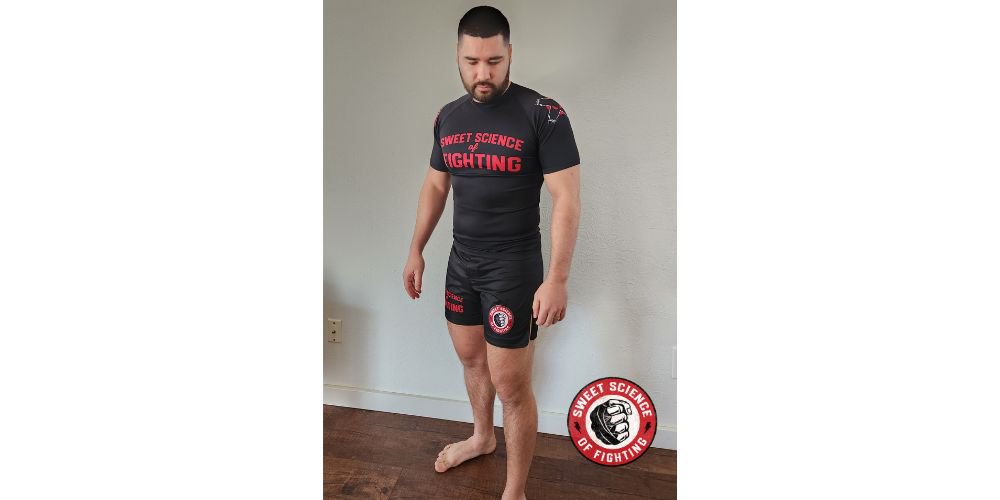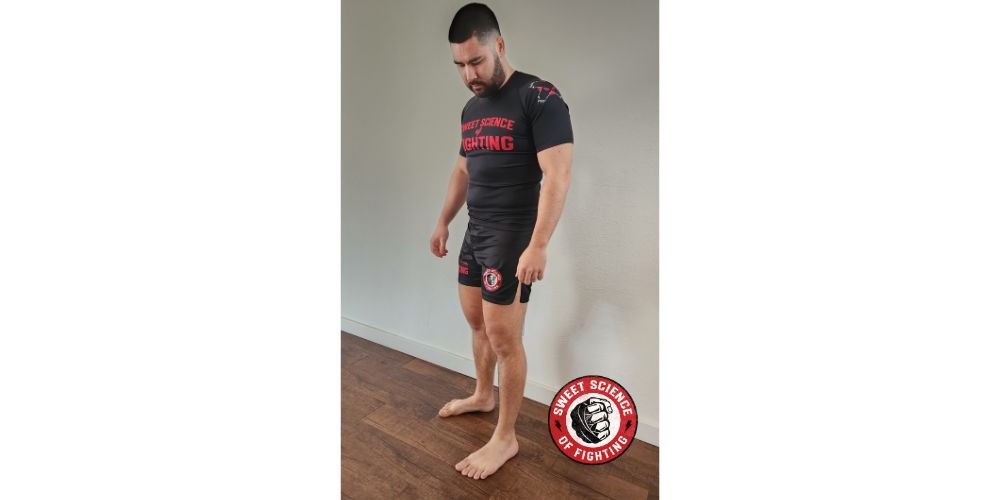As a high-contact sport, BJJ requires a layer of protection between the skin, mats, and other practitioners. Traditionally, this layer is the gi, but training and competing without it are ever-growing in popularity. For the most part, regular t-shirts have been used when people grapple without a gi, but since the rash guard has been adopted in jiu-jitsu, everyone has started wearing them. But one question bugs beginners when choosing their first ones, and this is how tight a rash guard should be.
A rash guard should be tight and form-fitting without being restrictive. This fit ensures the attire stays in place during grappling and protects the skin against mat burns and infections while allowing an unrestricted range of motion.
The materials used in manufacturing rash guards ensure a tight and comfortable feel, but only if you pick the right size and model for your frame. But before we reach the practical advice, I will remind you what makes rash guards so good for jiu-jitsu.
What Is A BJJ Rash Guard And Why Are They So Tight
A BJJ rash guard is a form-fitting athletic shirt worn for grappling practice and competition. The material and tight fit make rash guards excellent for preventing mat burns and protecting the skin from sweat and germs.
Initially, rash guards were created for surfers who needed to keep the sun, sand, and abrasive surface of their boards away from their skin, but no other community has adopted the rash guard as their own, quite like the grappling and MMA ones.
Most people in no-gi grappling use rash guards for every training session and competition. But rash guards are almost equally popular amongst gi practitioners, who still enjoy the skin protection of the rash guard with the bonus of keeping some of the sweat away from their expensive gis.
But do you have to use a rash guard?
No, there isn’t a rule set in stone for rash guards, and I haven’t encountered a gym that makes them mandatory. Most BJJ guys use them because they offer too many benefits without any drawbacks aside from the price. But some people train with tank tops, regular cotton t-shirts, or basic compression shirts.
So, let’s get over the benefits that have made rash guards the de facto uniform of no-gi grappling.
Skin Protection
As the name suggests, the primary purpose of a rash guard is to protect the skin from rashes, which can be caused by bacteria from the mat or other people. Rolling around with dozens of sweaty people on the same mat creates an environment for germs to flourish, and some people’s skin is less tolerant of such insidious attacks.
5 Step Blueprint To Build A BJJ Strength Workout To Demolish Your Opposition
Learn how to plan your strength training to maximize transfer to the mats.
A regular t-shirt protects your skin from direct contact, but a good rash guard usually has antibacterial treatment, which shields the skin much better.
Another key reason rash guards provide optimal protection is that the tight fit, which is the main topic of this article, ensures the rash guard will stay tight to your skin and will not move around or roll up and leave the skin unprotected during scrambles, inversions, and all kinds of crazy positions common in BJJ.
Comfort And Feel
Rash guards are made from polyester mixed with an elastic material like spandex, which makes them light and tight without being restrictive, flexible, durable, moisture-wicking, and quick-drying. Combining all those qualities makes rash guards super comfortable, especially for the demands of grappling.
Another feature that makes them feel so good is flatlock stitching, a technology for sewing the seams in a way that is barely noticeable and lays flat on the skin without causing any irritation or discomfort.
Visuals
BJJ-specific rash guards come in countless designs. The choice between graphics is endless, and you can choose from the most minimalistic ones to obscene, brash, or unapologetic visuals.
Rash guards can also be decorated with gym logos, team logos, personal affiliations, and generally whatever you want, making them perfect to reflect the wearer’s personality and please sponsors at the same time.
Durability and Safety
The problem with cotton t-shirts for jiu-jitsu training is twofold, and rash guards take care of both points.
First, cotton t-shirts are less durable, and the constant contact and movements have a high chance of tearing the fabric. The other reason is that normal T-shirts are usually not as tight as rash guards and can trap limbs or fingers. Even a very tight-fitting t-shirt can stretch easily, especially after it gets drenched with sweat.
All of those points lead to the main question at hand.
How Tight A Rash Guard Should Fit

A rash guard should be tight and form-fitting for all of the reasons above: it needs to remain in place and provide protection in all situations, and it should not distract you by moving around, all the while ensuring no limbs are caught in the action.
Some people say a rash guard should fit like a glove, and this is a decent comparison. But the metaphor I prefer is second skin.
A rash guard should feel like an extension of your skin and not a restrictive piece of clothing. The rash guard should let you move freely and with a full range of motion in all directions and not cause discomfort or restrictions.
A more tangible metric for a well-fitting rash guard is the fabric’s ability to be stretched to about an inch from your body and then return to its original position when released.
This is why a rash guard must be tight but not too tight. Rash guard materials are flexible, but if the size is too small, the fabric will not be able to stretch enough to make it comfortable. So, picking the right size is crucial.
What Size Rash Guard Should You Get

I’ve said multiple times that a rash guard should feel like a second skin, but at the end of the day, different people have their preferences, and picking a size should reflect that.
Some people just prefer a looser feel. Others who do not have the most athletic build may feel uncomfortable in a body glove, and there is nothing wrong with that.
Good rash guards have detailed size charts that let you choose based on your height and weight. You should also check the length and width of the rash guard, which are also usually provided by the manufacturer. Some brands, like XMartial rash guards, even let you choose if you want the product tighter or looser within the same size.
Another factor to consider when choosing a rash guard is the fabric blend, which determines the stretchiness.
Unfortunately, 80% polyester and 20% spandex from one brand does not necessarily equal the feel of the same blend from another brand, so the best option is to try them out first.
A rash guard feature I love and look for when choosing one is an anti-slip waistband. Only higher-class rash guards usually have them, but these waistbands can be a game changer.
While the fit usually ensures the rash guard will not roll up, it’s still possible in certain situations, which is when the rubber or gel waistband comes into play and keeps the clothing in place.
Summary
Rash guards are tight and form-fitting by design, and the perfect fit feels like a second skin. Because grappling is a sport where you are in constant contact with training partners and the mats, protecting the skin from all kinds of infections, burns, and scrapes is something everyone cares about. A rash guard’s tight but elastic fit ensures you receive this protection at all times while you can still move freely.
But the perfect fit is only possible with the right size. Choosing a rash guard that is too tight will be uncomfortable and may even restrict your blood flow. Taking one that is too baggy will drastically reduce the protection because it will easily roll up or move and leave your skin bare.

